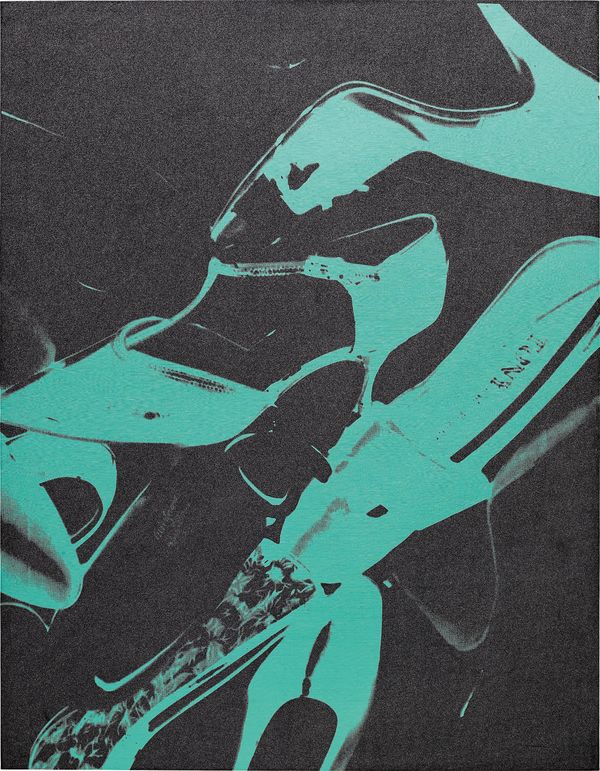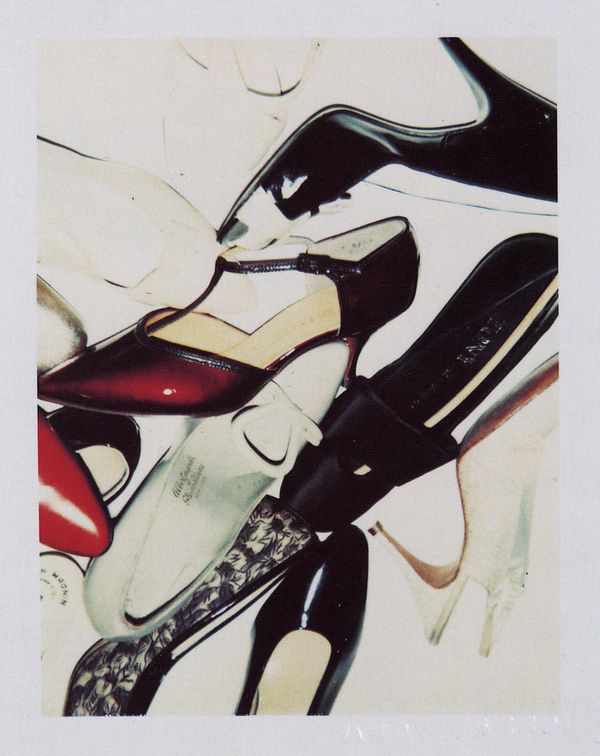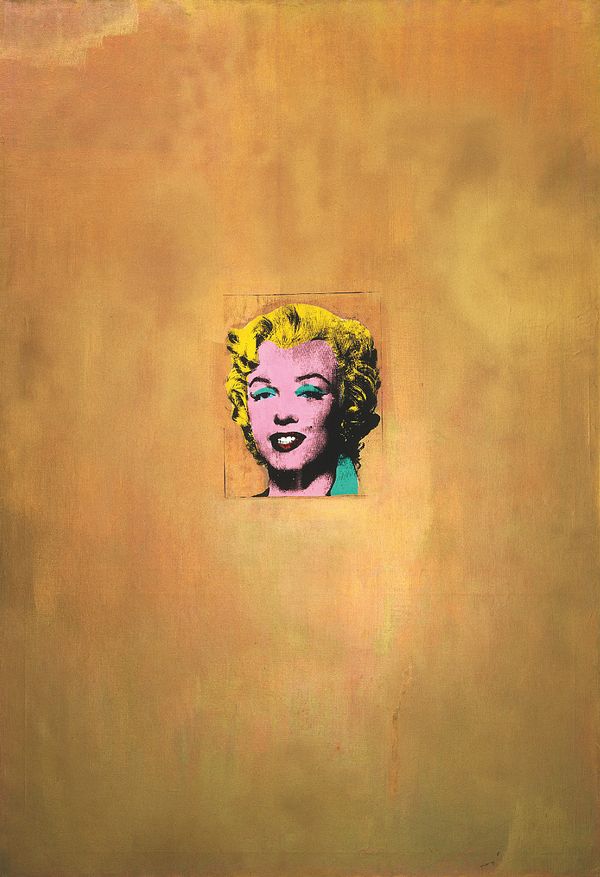Andy Warhol, Halston, Jack Jr. Haley [& Wife], Liza Minnelli and Bianca Jagger at Studio 54 by Robin Platzer © The LIFE Images Collection/Getty Images
I'm doing shoes because I'm going back to my roots. In fact, I think maybe I should do nothing but shoes from now on.
— Andy Warhol
Diamond Dust Shoes (Pink) and Diamond Dust Shoes (Green) from 1980 stem from one of Andy Warhol's most significant series. Each monumental composition encompasses the pioneering addition of 'diamond dust' to Warhol's long-established screen-printing technique as well as the near-fetishistic theme of shoes in his art.
The women's shoe as motif and theme in Warhol's work is perhaps the richest and most consistent of his oeuvre. The artist's concern with the subject matter was sparked in the early 1950s when the young artist achieved great success as a commercial illustrator for the likes of Harper's Bazaar, Vogue and shoe designer I. Miller and Sons. For his work for the latter, he was named by Women's Wear Daily as "the Leonardo da Vinci of the shoe trade." These illustrations, executed in his distinctive blotted line technique, were highly colored and whimsical in nature. Accompanied by playfully themed phrases or named after iconic movie stars such as Julie Andrews, these imagined objects held an inhabited quality and personality of their own. The high-heels depicted in Warhol's advertisements fully embodied the glamour and materiality of mid-century United States; this lay in stark contrast to the artist's humble upbringing by Slovakian immigrant parents. With his oeuvre anthologizing the glamourized and consumerist American way of life, from his fascination with idolism, to violence and commodity, the proliferation of Warhol's distinct concern with popular culture consequently led to the birth of Pop Art.
Warhol's Diamond Dust Shoes series originated as an ad-campaign assignment from his friend and fashion designer Roy Halston Frowick, known as Halston. Halston's boyfriend, Victor Hugo, is said to have sent down a big box of Halston shoes to Warhol's studio. When Ronnie Cutrone, Warhol's chief art assistant, tipped them out onto the floor, Warhol liked the way they looked. They took Polaroids of shoes laid out on white sheets of paper in a similarly spontaneous arrangement using shoes from Warhol's own collection and many more brought in for the same purpose.
The two works from our 20th Century & Contemporary Art Evening Sale in London are derived from the exact image of shoes strewn across the floor, the Polaroid exacerbating the contrast between color, shadow and graphically lettered labels that is brought out in the final canvas. The faint distinction of characters is evident amidst the dusted surface of the plane of each work.
Andy created the 'Diamond Dust Shoe' paintings just as the disco, lamé and stiletto of Studio 54 had captured the imagination of the Manhattan glitterati...
— Vincent Freemont
Andy Warhol Diamond Dust Shoes (Pink) and Diamond Dust Shoes (Green), 1980
Since the early 1970s, Polaroids had become Warhol's primary visual source following the transition from the found commercial image of his 1960s work. The artist made hundreds of the images that subsequently became the basis of his 'Society Portrait' commissions in addition to still lifes, and he favored the flattening effect and highly contrasting colors. Naturally, Warhol wanted shoes designed by Halston to be included in the images; the two were good friends during the Studio 54 era and frequented the club together with Bianca Jagger and Liza Minelli. Halston was at the height of his success, and thus those who were commissioning portraits by Warhol were visiting his Madison Avenue salon in order to be dressed by him.
Furthermore, it can be said that their relationship and collaboration influenced a series which in many ways perfectly represented the zeitgeist of New York in the early 1980s. As described by Vincent Freemont, "Andy created the Diamond Dust Shoe paintings just as the disco, lamé and stiletto of Studio 54 had captured the imagination of the Manhattan glitterati. Andy, who had been in the vanguard of the New York club scene since the early 1960s, once again reflected the times he was living in through his paintings." In both Diamond Dust Shoes (Green) and Diamond Dust Shoes (Pink), Warhol has brought the classic image of the stiletto heel to the fore. Executing the canvases in the starkly contrasting tones of rose pink and turquoise green set against the black glittered background, the artist intensifies the contrast evident in the source image, resulting in a hard-edged aesthetic reflective of the underground punk scene with which Warhol was associated.
Shoes — as a subject matter in art — possess the innate quality of representing the distinct personality of their inhabitant. They have been consistently utilized as a motif and representation of the self throughout art history, most prominently by Vincent Van Gogh in the 1880s. In these works, Van Gogh depicts a single pair of worn men's shoes against a simple background. In Shoes (1888, Metropolitan Museum of Art, New York), they are removed from their context as inanimate objects within a home, and instead the untidy laces and texture of the leather evoke the potential emotional and physical struggles of the anonymous owner. Echoing the sentiment of Van Gogh's shoe paintings, in Warhol's Diamond Dust Shoes the shoes can be viewed as a reflection of Warhol's own self — most specifically, with the artist as a master of self-representation and the construct of personal image.
Andy Warhol's Polaroid from the Diamond Dust Shoes series © The Andy Warhol Foundation for the Visual Arts, Inc. 2018 / Artists Rights Society (ARS), New York and DACS 2018
In addition to the hundreds of Polaroids which became the visual basis of his paintings, Warhol also created many self-portraits. In collaboration with photographer Christopher Makos, Warhol created a series of Polaroids styled with himself dressed in drag. In traditional portrait style, Warhol is depicted, at times professionally made up by a drag make-up artist and at others simply dressed in different blond wigs, vibrant lipsticks and exaggerated eye makeup. In some images, cropped just below the shoulders, Warhol wore a woman's off-the-shoulder top; in others, his overtly feminine makeup was contrasted with a white men's shirt and red checked tie. Diamond Dust Shoes can be linked to Warhol's preoccupation with drag and the concept of image in more ways than one: firstly, with the high-heeled shoe as the primary symbol of the drag style. Conspicuous in its femininity, the accessory is synonymous with the imitation of female style associated with drag to an even greater degree than the wig and makeup used by Warhol in the portraits. This is evident secondly, as a visual manifestation of the many guises and personalities created by the artist. Where Van Gogh's image of a singular pair signaled the independent identity of one character, Warhol's jumble of mismatching shoes seem to refer to his own numerous visual identities. Throughout his career, he perfected a series of carefully cultivated images; he was rarely seen without the wigs and glasses that became part of his signature look. These symbols of his outwardly projected personality were made up of easily removable and inter-changeable costumes.
He famously said, as quoted in Los Angeles Free Press in March 1967, "If you want to know all about Andy Warhol, just look at the surface of my paintings and films and me, and there I am. There's nothing behind it."
Andy Warhol Gold Marilyn Monroe, 1962. Museum of Modern Art, New York © The Andy Warhol Foundation for the Visual Arts, Inc. 2018 / Licensed by DACS.Museum of Modern Art, New York/Scala, Florence
Warhol's notion of 'surface' is further expanded with the artist's material process. The addition of 'diamond dust' to his established screen-printing technique came about in 1979 when his chief printer Rupert Jasen Smith, who had been using the powder in some of his own prints, introduced him to the industrial-grade ground-up stones. However, Warhol found the product to give too chalky an effect and instead settled on pulverised glass to provide the dazzling appearance he was looking for. The shimmering texture of this method provides literal glamour, yet the cheap, mass-produced material used to create the illusion of the ultimate symbol of wealth conforms perfectly with Warhol's most iconic theme: the mass-consumerism of 20th century America. This approach is comparable to his use of gold paint and silkscreen inks in his 1962 image of Marilyn Monroe in the Museum of Modern Art. The expansive gold background directly references the gold leaf used in Christian iconographic images; however, in Warhol's pop rendering, Christ or the Virgin Mary is replaced with Marilyn Monroe, reproduced from a found promotional image.
In Diamond Dust Shoes, these objects are elevated in a similar way through their monumental size and glittering representation. Warhol was raised as a Byzantine Catholic by his Slovakian parents and attended church every week throughout his life; he had an audience with Pope John Paul II in 1980, and is buried in St. John the Baptist Byzantine Catholic Cemetery in Pittsburgh. In their production, Diamond Dust Shoes (Pink) and Diamond Dust Shoes (Green) recall the often precious and jewelled icons and relics that inhabit churches and play a central role in worship.
Warhol's shoes importantly bridge the artist's outward projection of identity in artistic maturity and his historical and cultural origins.




